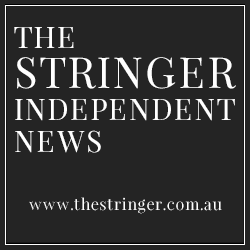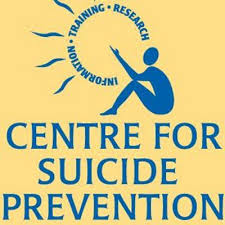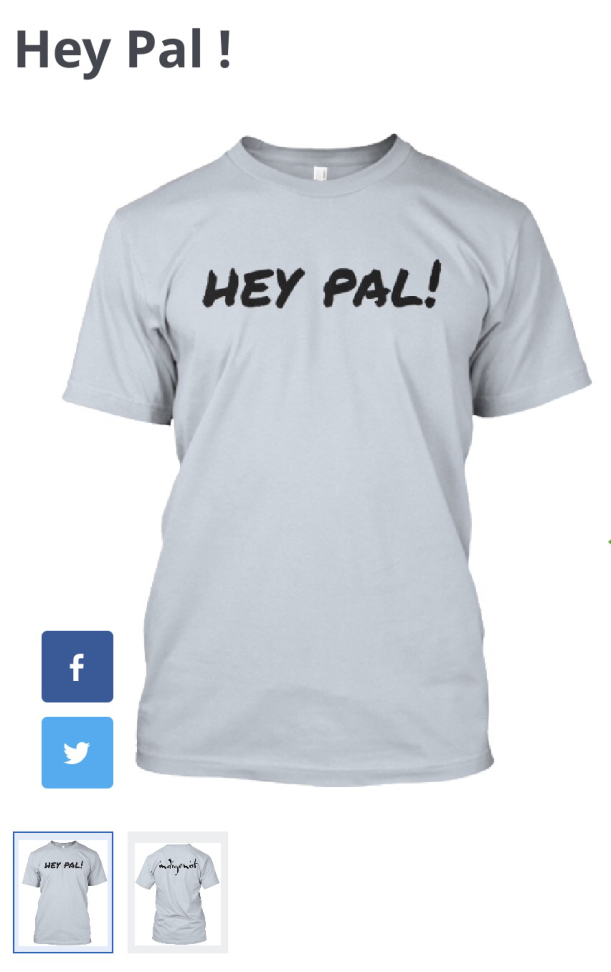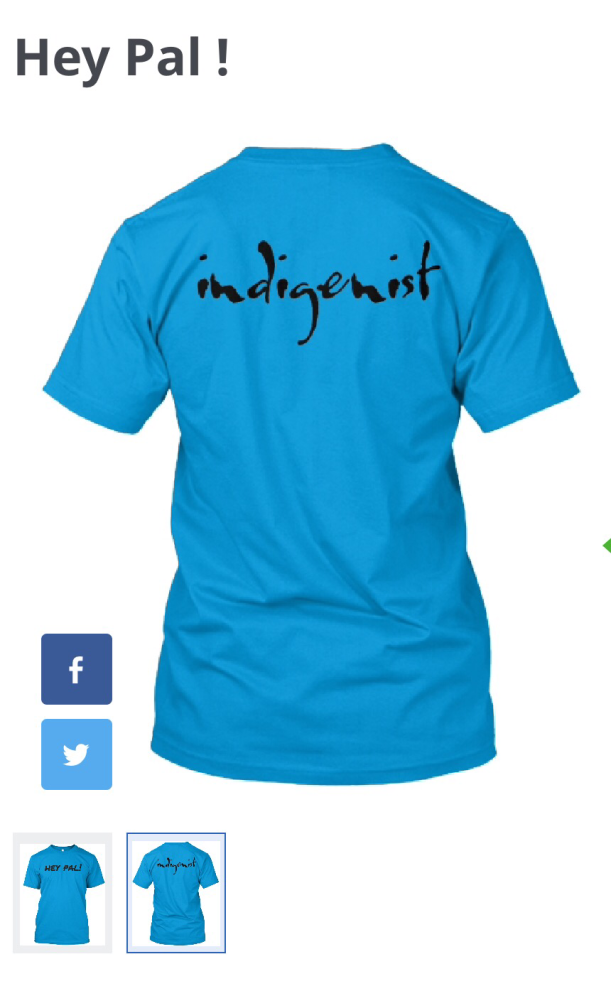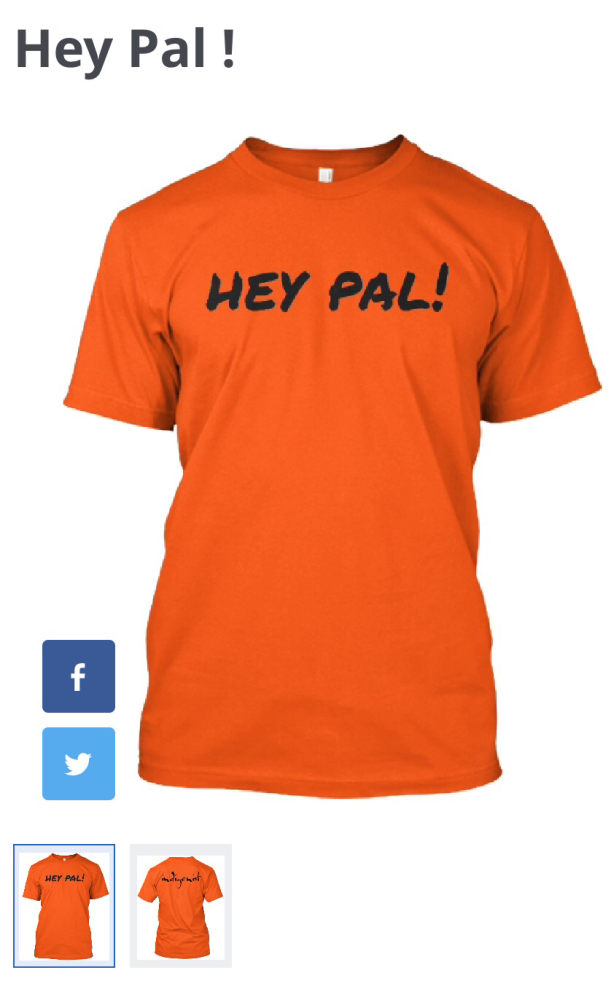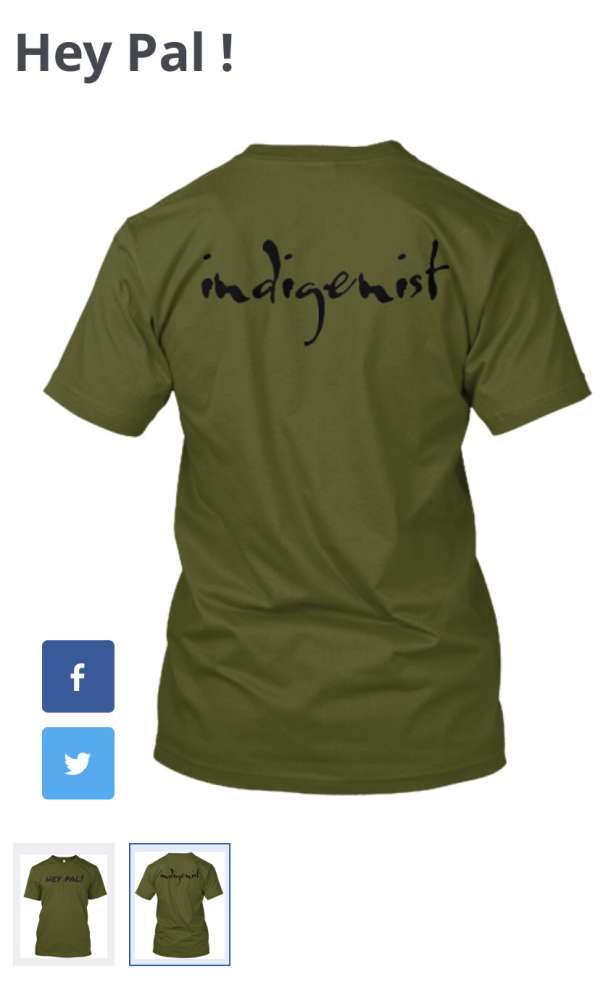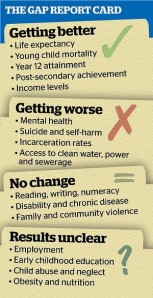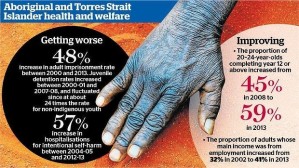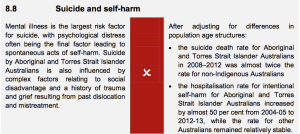Category Archives: Indigenous Suicide Prevention
The Call To Action – Indigenous LGBTI Suicide Prevention (video)
The Call To Action – Indigenous Suicide Prevention
The suicidality of the Aborginal and Torrres Strait Islander LGBQTI people is an unknown. International ananlytis shows that at the intersection of being both Indigenous/First Nation/NAtive and of LGBQTI indentity places us as the most at risk group in the world.
Your support can help respond to that. It will help save lives and increase the quality of life for so many.
Our Video
See more at: http://startsomegood.com/blackrainbow
Suicide in first nations LGBTI community has not been widely spoken of, or included in health promotion – Radio Interview on @LivingBlakSBS
The Black Rainbow Living Well Foundation aims to support Indigenous LGBTI Australians in living well.
QUITE tragically, as you are reading these first few words there is a high probability somebody will attempt to end their life by suicide. There is even a higher probability that that somebody is part of the LGBTI community, particularly if they are at the point of self-realisation and disclosure. If that person is an Indigenous Australian, the probability amplifies yet again.
How do I know this? Because that’s what the evidence suggests. LGBTI people are said to have the highest rates of self-harm and suicide of any population in Australia. Same-sex attracted Australians are said to exhibit up to 14-times-higher rates of suicide attempts than their heterosexual peers. Yet, according to the Australian Bureau of Statistics, there were 996 suicides reported across Australia between 2001 and 2010 among Indigenous peoples. We are told that 1.6 per cent of all Australians die by suicide but for Indigenous peoples, this rate is more than 4.2 per cent, or one in every 24.
How do I know this? Because that’s what the evidence suggests. LGBTI people are said to have the highest rates of self-harm and suicide of any population in Australia. Same-sex attracted Australians are said to exhibit up to 14-times-higher rates of suicide attempts than their heterosexual peers. Yet, according to the Australian Bureau of Statistics, there were 996 suicides reported across Australia between 2001 and 2010 among Indigenous peoples. We are told that 1.6 per cent of all Australians die by suicide but for Indigenous peoples, this rate is more than 4.2 per cent, or one in every 24.
As mentioned, the evidence only suggests this because we are coalescing the data from two different groups and hypothesising the math. In other words we aren’t really sure.
But we need too be sure. We need to know.
Internationally we know that 47.3% American Indian and Alaskan Native adolescent men in Minnesota who identified as gay had considered suicide, compared with 23.6% of their straight peers, and that 23.2% of gay youth had attempted suicide, compared with 11.1% of their straight peers. These are fearful statistics of lives lost and lives in distress.
Determining the size of the Aboriginal and Torres Strait Islander lesbian, gay, bisexual, and transgender population is difficult. However, recent studies by Gates and Newport (2012) in the United States estimated the percentage of Americans who identify as LGBTI at approximately 3 to 4 per cent.
According to the ABS, “Within the Aboriginal and Torres Strait Islander population there were an estimated 294,000 children and young people, representing 4.2 per cent of the total Australian population aged 0 to 24 years.” Therefore in using the American figure of 3 to 4 per cent, there is potentially 10,000 Aboriginal and Torres Strait Islander who are LGTBI and whose needs are yet to be identified and met.
Phase 1
Creation of The Black Rainbow National Leadership Group
*** A national scoping project will be facilitated by myself and relevant stakeholders to engage a reference group of Aboriginal and Torres Strait Islander people who identify as either Lesbian, Gay, Bisexual, Queer, Trans and/or Intersex (LGBQTI); Including Brotherboy and Sistergirl. Membership will also extend to an Aboriginal and Torres Strait Islander person who identifies as Heterosexual.
*** The name of this group will be The Black Rainbow National Leadership Group.
The Black Rainbow National Leadership Group will:
*** Connect and identify key stakeholders to generate discussion with and create relationships.
*** Identify a national support stakeholder network that is able to undertake half-day workshops to determine the health issues, healing needs and the needs of Aboriginal and Torres Strait Islander LGBQTI persons, and
*** As a group we will travel to Canberra in the second half of 2015 to meet with government and non-government departments and organisations for guidance and financial assistance and to make The Black Rainbow Living Well Foundation a reality.
*** The Monies raised above and beyond $25,000 will go toward a national gathering for Aboriginal and Torres Strait Islander LGBTI persons. The gatheirng will be to workshop reponses to the health issues, healing needs
Phase 2
To date my (joint) proposal “Intersecting Indigenous Rainbows – International LGBT First Nations and Two-Spirited People in Suicide Prevention” has been accepted for presentation and workshop by the Scientific Committee of the International Association for Suicide Prevention. This is a collaborative international workshop to be co-facilitated by a Two-Spirit Aboriginal Canadian.
I will attend the 28th World Congress of the International Association for Suicide Prevention (IASP) to be held from June 16th to 20th, 2015 in Montreal.
I intend to visit with other leaders in Indigenous suicide prevention across Canada in Alberta, Saskatchewan, Winnipeg and Ontario including those working specifically with Two-Spirit people. These plans are already underway.
In 2015 a self funded insider research paper I undertook and wrote titled “Voices from the Black Rainbow: The inclusion of the Aboriginal and Torres Strait Islander LGBQTI Sistergirl and Brotherboys people in health, wellbeing and suicide prevention strategies” will also published.
Phase 3
Co-write a report and produce the first ever, international document on the comparative analysis of social determinants of health facing Indigenous LGBQTI and how to best enhance resilience, at a global and community level. We will draw on the preliminary findings of the workshop in Montreal.
We intend to deliver this report, in person, to the United Nations for consideration.
Phase 4
The Black Rainbow National Leadership Group will identify a national network of Aboriginal and Torres Strait Islander organisations and stakeholders to support and assist in a national gathering of Aboriginal and Torres Strait Islander LGBQTI persons that will determine, and unpack appropriate and agreed healing activities which can generate empowerment, healing and leadership that will inform national health plans and strategies.
This will also be when we will travel to Canberra.
Phase 5
If successful in meeting with these stakeholders the national workshops will be rolled out and will inform a localised briefing paper identifying the issues facing Aboriginal and Torres Strait Islander LGBQTI community.
This paper will be used as an advocacy tool for the national gathering with members of the Aboriginal and Torres Strait Islander LGBQTI community.
This gathering will be an opportunity to unpack the issues (highlighted in the briefing paper) and identify best practice responses.
A Call to Action
The suicidality of the Aborginal and Torrres Strait Islander LGBQTI people is an unknown. International ananlytis shows that at the intersection of being both Indigenous/First Nation/NAtive and of LGBQTI indentity places us as the most at risk group in the world.
Your support can help respond to that. It will help save lives and increase the quality of life for so many.
You can follow us at Black Rainbow on Facebook www.facebook.com/BlackRainbowAustralia
We are also on Twitter @BlkRnBow
Coming soon on Instagram blackrainbowaus
See more at: http://startsomegood.com/blackrainbow
Tipping Point Goal: $25,000
Total Funding Goal: $100,000
Tipping Point goal
Phases 1 – 3 will be achieved at tipping point
Phase 1 – Creation of The Black Rainbow National Leadership Group
Phase 2 – Delivering workshop at 28th World Congress of the International Association for Suicide Prevention (IASP) to be held from June 16th to 20th, 2015 in Montreal
Phase 3 – Co-write a report and produce the first ever, international document on the comparative analysis of social determinants of health facing Indigenous LGBQTI and how to best enhance resilience, at a global and community level.
Once $25,000 has been reached all monies beyond will go toward achieving the following
Phase 4
The Black Rainbow National Leadership Group will identify a national network of Aboriginal and Torres Strait Islander organisations and stakeholders to support and assist in a national gathering of Aboriginal and Torres Strait Islander LGBQTI persons that will determine, and unpack appropriate and agreed healing activities which can generate empowerment, healing and leadership that will inform national health plans and strategies.
Phase 5
If successful in meeting with these stakeholders the national workshops will be rolled out and will inform a localised briefing paper identifying the issues facing Aboriginal and Torres Strait Islander LGBQTI community.
This paper will be used as an advocacy tool for the national gathering with members of the Aboriginal and Torres Strait Islander LGBQTI community.
This gathering will be an opportunity to unpack the issues (highlighted in the briefing paper) and identify best practice responses.
Ultimate goal
The ultimate is for the Black Rainbow Living Well Foundation to become a national entity.
From this campaign it is hoped to achieve national gathering for members of the Aboriginal and Torres Strait Islander LGBTI community to attend to workshop solutions and ways forward to strengthen the social and emotional wellbeing (mental health) our community.
To achieve this we will need to deliver the finalized report to Canberra and have audience with the Australian government and other national stakeholders to rally support; both in kind and financial.
See more at: http://startsomegood.com/blackrainbow
Our Video
A welcomed response from WA Minister – Hon. Helen Morton. Thank you. Dameyon
Suicide in first nations LGBTI community has not been widely spoken of, or included in health promotion.
Suicide in first nations LGBTI community has not been widely spoken of, or included in health promotion.
Dameyon Bonson talks to Living Black Radio about his findings and why he works with the first nations Gay Lesbion, Bi, Trans and Intersex coomunity to prevent suicide and self harm, particularly for young people.
Indigenous Suicide – Preliminary Recommendations
Indigenous Suicide – Preliminary Recommendations
In reference to the Kimberley, the Yiriman Project should be further supported and where possible rolled out across as much of the region as is culturally appropriate.
The Halls Creek Healing Taskforce and Strategy should be further supported.
There should be adequate investment in developing cultural festivals. Three-year funding cycles should be the minimum requirement in order to enable budget stability and planning and coordination requirements.
Further funding for the charity Feed the Little Children.
Funding for LGBTI programs and projects among First Peoples.
There should arise an acknowledgment of those incarcerated as the highest need group and in supporting them with healing and with positive ways forward, in empowering them, it may well arise that this will significantly reduce the suicide rates.
Halfway houses for those needing them after being released from prison.
The Custody Notification Service which has been in operation in NSW since 1998 has led to zero police watch house deaths of First Peoples should be implemented in every State and Territory in the nation.
This would be the good start, long overdue…
“From the article Kimberley suicide rate, one of the world’s highest – Yiriman is the way to go” in
The Stringer
The 5 Things We Wish ALL Teachers Knew About How to Welcome Back a Student who Experienced Suicidality
Q & A from Webinar #10:

The 5 Things we wish ALL Teachers knew about … How to welcome back a student who experienced suicidality
This was my question :
1. What is the universal definition of “Suicide Prevention” or how does Canada define it?
The range of efforts and resources that those in mental health make available to enhance someone’s safety from suicidal behaviour is generally how suicide prevention is defined.
Here at the Centre for Suicide Prevention we believe that prevention is the only solution to suicide. We teach prevention by educating people with the information, knowledge and skills necessary to respond to the risk of suicide. Suicide Prevention is the term typically used to describe Suicide PIP or Prevention, Intervention and Postvention. Prevention in and of itself, ideally, would obviate the need to have the subsequent stages in suicide awareness, intervention and postvention, in place. Sadly, this has not been achieved as yet but it is a goal.
For the remaining 5 Webinar 10_Q A
Here is the link for all TEN webinars in this series.
Many thanks to the Centre for Suicide Prevention, Calgary – Canada
#HeyPal : A salutation is a greeting used in a letter or other written or non-written communication.
A salutation is a greeting used in a letter or other written or non-written communication. Salutations can be formal or… informal. The most common form of salutation is Hey Pal !
[BLOG POST TO FOLLOW] – Overcoming Indigenous Disadvantage: Key Indicators 2014
Overcoming Indigenous Disadvantage: Key Indicators 2014 The Overcoming Indigenous Disadvantage report measures the wellbeing of Australia’s Indigenous peoples. The report provides information about outcomes across a range of strategic areas such as early child development, education and training, healthy lives, economic participation, home environment, and safe and supportive communities. The report examines whether policies and programs are achieving positive outcomes for Indigenous Australians.
Please note: Aboriginal and Torres Strait Islander people are advised that this website may contain images of deceased people.
Overcoming Indigenous Disadvantage Key Indicators
When oppression is underlying cause of mental health unrest in Indigenous people we need to name it a mental injury, not an illness.
When oppression is underlying cause of mental health unrest in Indigenous people we need to name it a mental injury, not an illness.
It’s not something that was caught or a disease. It’s something that has happened.
Eradicating oppression is the first step to the eradication mental injury and mental health unrest.
Eradicating oppression is suicide prevention.
© Indigenist™ 2014
Effective strategies to strengthen the mental health and wellbeing of Aboriginal and Torres Strait Islander people
Effective strategies to strengthen the mental health and wellbeing of Aboriginal and Torres Strait Islander people
Issues paper no. 12 produced for the Closing the Gap Clearinghouse
Pat Dudgeon, Roz Walker, Clair Scrine, Carrington Shepherd, Tom Calma and Ian Ring November 2014
What doesn’t work
- Programs that fail to take account of Indigenous values, lifestyles, aspirations, family and differing needs and capacities of Indigenous people in diverse, complex economic and social circumstances.
- Programs and services developed with inadequate timeframes, funding and program support that fail to address health in a holistic manner and focus on the individual without regard for the family and community context.
- Provision or adaptation of mainstream programs by mainstream providers for Indigenous people without Indigenous community involvement or consultation.
- Programs that are short-term, inflexible and designed and delivered without consultation, engagement and partnership with the community and the Aboriginal Community Controlled Health Service sector.
- Poor engagement with research evidence by the mainstream sector can lead to systemic racism, lack of cultural understanding and appropriateness, and a reliance on ‘one size fits all’ approaches.
- Performance indicators and reporting requirements, developed in accordance with the values and principles of the mainstream mental health system, that do not always align with Indigenous cultural ways of working and views of social and emotional wellbeing.
What works
There is evidence that programs that are developed or implemented in accordance with the 9 guiding principles underpinning the National Strategic Framework for Aboriginal and Torres Straits Islander Peoples’ Mental Health and Social and Emotional Well Being 2004–2009 (SHRG 2004) are more likely to be effective and have positive outcomes than those that do not.
- Programs that show promising results for Indigenous social and emotional wellbeing are those that encourage self-determination and community governance, reconnection and community life, and restoration and community resilience.
- Important program features include:
– a holistic approach
– a focus on recovery and healing from stress and trauma
– a means of empowering people to regain a sense of control and mastery over their lives
– strategies that are Indigenous-led, family focused, culturally responsive, and context specific
– interdisciplinary approaches that provide outreach services and transport
– partnerships with the Aboriginal Community Controlled Health Services sector and local communities. - There is evidence that both mainstream and Indigenous-specific programs and services that adhere to the Closing the Gap service-delivery principles of engagement, access, integration and accountability are more effective than those that do not.
- ‘Participatory action research’ approaches provide an effective mechanism for involving Indigenous families and communities in developing, implementing and evaluating programs. Programs that adopt participatory action research tend to be more culturally responsive to local contexts and foster a culturally safe environment for program participants.
- Engaging in cultural activities is an indicator of positive cultural identity that is associated with better mental health among Indigenous Australians.
FULL REPORT HERE :


